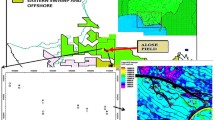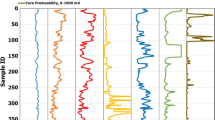Abstract
A key challenge in the oil and gas industry is the ability to predict key petrophysical properties such as porosity and permeability. The predictability of such properties is often complicated by the complex nature of geologic materials. This study is aimed at developing models that can estimate permeability in different reservoir sandstone facies types. This has been achieved by integrating geological characterization, regression models and artificial neural network models with porosity as the input data and permeability as the output. The models have been developed, validated and tested using samples from three wells and their predictive accuracy tested by using them to predict the permeability in a fourth well which was excluded from the model development. The results indicate that developing the models on a facies basis provides a better predictive capability and simpler models compared to developing a single model for all the facies combined. The model for the combined facies predicted permeability with a correlation coefficient of 0.41 which is significantly lower than the correlation coefficient of 0.97, 0.93, 0.99, 0.96, 0.96 and 0.85 for the massive coarse-grained sandstones, massive fine-grained sandstones-moderately sorted, massive fine-grained sandstones-poorly sorted, massive very fine-grained sandstones, parallel-laminated sandstones and bioturbated sandstones, respectively. The models proposed in this paper can predict permeability at up to 99% accuracy. The lower correlation coefficient of the bioturbated sandstone facies compared to other facies is attributed to the complex and variable nature of bioturbation activities which controls the petrophysical properties of highly bioturbated rocks.














Similar content being viewed by others
References
Ben-Awuah J, Padmanabhan E, Sokkalingam J (2017) Geochemistry of miocene sedimentary rocks from offshore West Baram Delta, Sarawak Basin, Malaysia, South China Sea: implications for weathering, provenance, tectonic setting, paleoclimate and paleoenvironment of depostion. Geosc J
Ben-Awuah J, Padmanabhan E, Andriamihaja S, Amponsah PO, Ibrahim Y (2016) Petrophysical and reservoir characteristics of sedimentary rocks from offshore West Baram Delta, Sarawak Basin, Malaysia. Pet and Coal 56(4):414–429
Ben-Awuah J, Padmanabhan E (2015) Effect of bioturbation on reservoir rock quality of sandstones: a case study from the Baram Delta, offshore Sarawak, Malaysia. J Pet Explor Dev 42(2):1–9
Ben-Awuah J, Padmanabhan E (2014) Impact of bioturbation on reservoir quality: a case study of biogenically reduced permeabilities of reservoir sandstones of the Baram Delta, Sarawak, Malaysia. J Appl Sci 14(23):3312–3317
Boggs S Jr (2009) Petrology of sedimentary rocks, 2nd edn. Cambridge University Press, London
Bromley RG (1990) Trace fossils: biology and taphonomy. Unwin Hyman, London
Camargo SD, Engel PM (2012) Predicting reservoir quality in sandstones through neural modelling. Vetor 22(1):57–70
Cullen A (2014) Nature and significance of the West Baram and Tinjar Lines, NW Borneo. Mar Pet Geol 51:197–209
Doust H (1981) Geology and exploration history of offshore central Sarawak, Energy resources of the pacific region Am Assoc Pet Geol Stud Geol 12:117–132.
Evans D, Jones AJ (2002) A proof of the gamma test. Proc Roy Soc London A458:2759–2799
Fausett LV (1994) Fundamentals of neural networks: architecture, algorithms, and applications. Prentice-Hall, New Jersey
Gingras MK, Baniak G, Gordon J, Hovikoski J, Konhauser KO, La Croix A, Lemiski R, Mendoza C, Pemberton SG, Polo C, Zonneveld JP (2012) Porosity and permeability in bioturbated sediments. Dev Sedimentol 64:837–868
Gordon JB, Pemberton SG, Gingras MK, Konhauser KO (2010) Biogenically enhanced permeability: a petrographic analysis of Macaronichnus segregatus in the Lower Cretaceous Bluesky Formation, Alberta, Canada. Am Assoc Pet Geol Bull 94(11):1779–1795
Goncalves CA, Harvey PK, Lovell MA (1997) Prediction of petrophysical parameter from logs using a multilayer backpropagation neural network. In: Lovell MA, Harvey PK (eds) Developments in Petrophysics, vol 122. Geol Soc Spec Publ, London, pp 169–180
Hall R (2002) Cenozoic geological and plate tectonics evolution of SE Asia and the SW Pacific: computer-based reconstructions, model and animations. J Asian Earth Sci 20:353–431
Haykin SS (1999) Neural networks: a comprehensive foundation, 2nd edn. Prentice Hall, New Jersey
Ho KF (1978) Stratigraphic framework for oil exploration in Sarawak. Bull Geol Soc Malays 10:1–13
Hsieh AI, Allen DM, MacEachern JA (2015) Statistical modelling of biogenically enhanced permeability in tight reservoir rocks. Mar Pet Geol 65:114–125
Hutchinson CS (2005) Geology of north West Borneo: Sarawak, Brunei and Sabah, 1st edn. Elsevier, New York
Iturraran-Viveros U, Parra JO (2014) Artificial Neural Networks applied to estimate permeability, porosity and intrinsic attenuation using seismic attributes and well-log data. J Appl Geophys 107:45–54
Jensen J, Currie I (1990) A new method for estimating the Dykstra-Parsons coefficient to characterize reservoir heterogeneity. SPE Reserv Eng 5(3):369–374
Johnson HD, Kudd T, Dundang A (1989) Sedimentology and reservoir geology of the Betty field, Baram Delta Province, offshore Sarawak, NW Borneo. Bull Geol Soc Malays 25:119–161
Jones AJ (2004) New tools in non-linear modeling and prediction. Comput Manag Sci 1:109–149
Khidir A, Catuneanu O (2010) Reservoir characterization of Scollard-age fluvial sandstones, Alberta foredeep. J Mar Pet Geol 27(9):2037–2050
Khidir A, Catuneanu O (2009) Basin-scale distribution of authigenic clay minerals in the late Maastrichtian-Early Paleocene fluvial strata of the Alberta foredeep: implications for burial depth. Bull Can Petrol Geol 57(3):251–274
Ligtenberg JH, Wansink AG (2001) Neural network prediction of permeability in the EL Garia Formation, Ashtart oilfield, offshore Tunisia. J Pet Geol 4:389–404
Love KM, Strohmenger C, Woronow A, Rockenbauch K (1997) Predicting reservoir quality using linear regression models and neural networks. In: Kupecz JA, Gluyas J, Bloch S (eds) Reservoir quality prediction in sandstones and carbonate. Am Assoc Pet Geol 69:47–60
Madon M, Cheng Ly K, Wong R (2013) The structure and stratigraphy of deepwater Sarawak, Malaysia: implications for tectonic evolution. J Asian Earth Sci 76:312–333
Madon M (1999) Geological setting of Sarawak. In: Meng LK (ed) The petroleum geology and resources of Malaysia. PETRONAS, Kuala Lumpur, pp 275–290
Martens H, Naes T (1992) Multivariate calibration. Wiley, Chichester
Morad S, Al-Ramadan K, Ketzer JM, De Ros LF (2010) The impact of diagenesis on the heterogeneity of sandstone reservoirs: a review of the role of depositional facies and sequence stratigraphy. Am Assoc Pet Geol Bull 94:1267–1309
Moraes MA, Surdam RC (1993) Diagenetic heterogeneity and reservoir quality; fluvial, deltaic and turbiditic sandstone reservoirs Potiguar and Reconcavo rift basins Brazil. Am Assoc Pet Geol Bull 77:1142–1158
Molnar P, Tapponnier P (1975) Cenozoic tectonics of Asia: effects of a continental collision. Sci New Ser 189:419–426
Pemberton SG, Gingras MK (2005) Classification and characterization of biogenically enhanced permeability. Am Assoc Pet Geol Bull 89:1493–1517
Pettijohn FJ (1975) Sedimentary rocks. Harper and Row, New York
Rogers SJ, Chen HC, Kopaska-Merkel DC, Fang JH (1995) Predicting permeability from porosity using artificial neural networks. Am Assoc Pet Geol Bull 79:1786–1797
Roller C, Driskill B, Manrique J (2009) Use of the Allan variance for characterizing reservoir heterogeneity. SPWLA 50th Ann Logg Symp, Texas
Rijks EJH (1981) Baram Delta geology and hydrocarbon occurrence (Sarawak). Geol Soc Malays Bull 14:1–8
Ryan WBF, Carbotte SM, Coplan JO, O’Hara S, Melkonian A, Arko R, Zemsky R (2009) Global multi-resolution topography synthesis. Geochem Geoph Geosys 10(3)
Selly RC (1996) Ancient sedimentary environments and their sub-surface diagnosis. Chapman and Hall, London
Stefansson A, Koncar N, Jones AJ (1997) A note on the gamma test. Neural Comp and Applic 5:131–133
Singh S, Kanli AI, Sevgen S (2016) A general approach for porosity estimation using artificial neural network method: a case study from Kansas gas field. Studia Geoph Et Geod 60:130–140
Singh S, Kanli AI (2016) Estimating shear wave velocities in oil fields: a neural network approach. Geosci J 20:221–228
Sudirman SB, Samsudin YB, Darman NH (2007) Planning for regional EOR pilot for Baram Delta, offshore Sarawak, Malaysia: Case study, lessons learnt and way forward. SPE Asia Pac Oil Gas Conf, Jakarta
Tan DNK, Abd. Rahman AH, Anuar A, Bait B, Tho CK (1999) West Baram Delta. In: Meng LK (ed) The petroleum geology and resources of Malaysia. PETRONAS, Kuala Lumpur, pp 291–341
Taner M (1995) Neural networks and computation of neural network weights and biases by the generalized delta rule and back-propagation of errors. Rock Solid Images (http://rocksolidimages.com/pdf/neural_network.pdf)
Taylor AM, Goldring R (1993) Description and analysis of bioturbation and ichnofabric. J Geol Soc 150:141–148
Tobin RC (1997) Porosity prediction in frontier basins: a systematic approach to estimating subsurface reservoir quality from outcrop samples. In: Kupecz JA, Gluyas J, Bloch S (eds) Reservoir quality prediction in sandstones and carbonate. Am Assoc Pet Geol Mem 69:1–18
Tonkin NS, McIlroy D, Meyer R, Moore-Turpin A (2010) Bioturbation influence on reservoir quality: a case study from the Cretaceous Ben Nevis Formation, Jeanne d’Arc Basin, offshore Newfoundland, Canada. Am Assoc Pet Geol Bull 94:1059–1078
Tucker ME (2003) Sedimentary rocks in the field, 3rd edn. Wiley, London
Verma AK, Cheadle BA, Routray A, Mohanty WK, Mansinha L (2014) Porosity and permeability estimation using neural network approach from well log data. Am Assoc Pet Geol Search Disc 41276
Washburn KE, Birdwell JE (2013) Multivariate analysis of ATR-FTIR spectra for assessment of oil shale organic geochemical properties. Org Geochem 63:1–7
Acknowledgments
This work is partly supported by the FRGS grant awarded to Eswaran Padmanabhan by the Ministry of Higher Education, Malaysia. The authors are grateful to PETRONAS for the samples and permission to publish the data. The first author is also grateful to the Universiti Teknologi PETRONAS (UTP) for funding his PhD studies and the staff at PETROGEO Oil and Gas Consults Ltd. for their technical input and to the anonymous reviewers for their insightful comments.
Author information
Authors and Affiliations
Corresponding author
Rights and permissions
About this article
Cite this article
Ben-Awuah, J., Padmanabhan, E. An enhanced approach to predict permeability in reservoir sandstones using artificial neural networks (ANN). Arab J Geosci 10, 173 (2017). https://doi.org/10.1007/s12517-017-2955-7
Received:
Accepted:
Published:
DOI: https://doi.org/10.1007/s12517-017-2955-7




